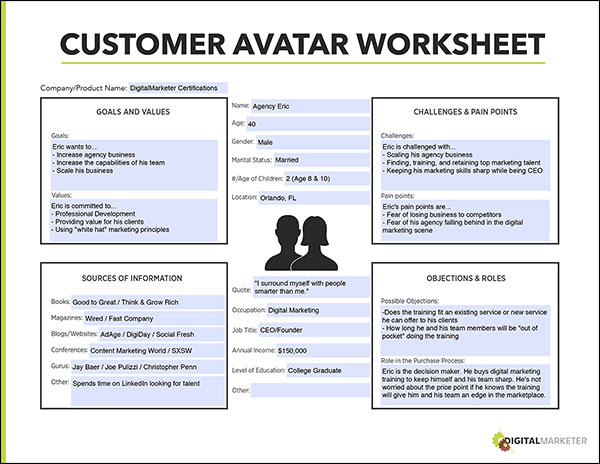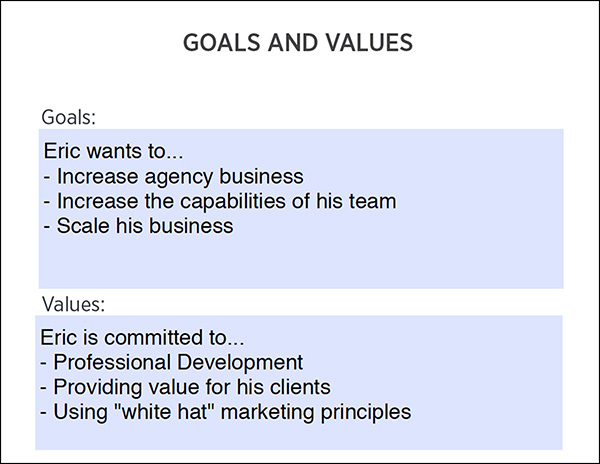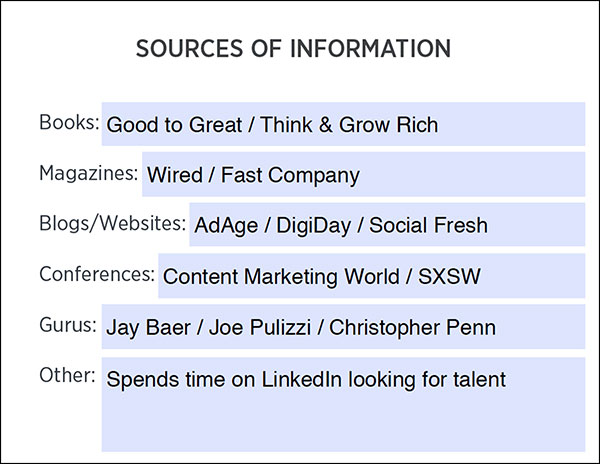

It’s a huge mistake.
And yet, I see it happen all the time.
A marketer or business owner gets so focused on WHAT they’re selling that they forget to think about WHO they’re selling it to.
This is the kiss of death for a marketing campaign, and sometimes even an entire business.
You could have the greatest product on earth, but if you’re trying to sell it to the wrong person—you’re never going to hit your sales numbers.
That’s why understanding your customer avatar (AKA buyer persona) is so important.
That’s also why we created the Customer Avatar Worksheet (that you can download for FREE), to help you document everything about your customer avatar.
Before you can sell anything effectively, you need to understand…
- WHO your ideal customer is
- WHERE they’re hanging out online
- WHAT their challenges are
But how do you actually do all that?
Don’t worry—I’ll dig into the details later on in this post. First, I want to make sure you understand why customer avatars are so important, and why I refer to them as the “Swiss army knife” of marketing.
The Swiss Army Knife of Marketing
Digital marketing is composed of a lot of different disciplines.
There’s content marketing, email marketing, paid traffic, product creation, social media, copywriting, analytics… the list goes on.
Each of those disciplines has its own unique set of skills to master.
But knowing how to identify your customer avatar is one of the few skills that applies to every marketing discipline. That’s what makes it the Swiss army knife—you can use it in every single marketing discipline.
For example…
- Content Marketing: Knowing your avatar helps you decide what blog posts, videos, podcasts, Lead Magnets, etc. you should create to attract more leads and customers
- Paid Traffic: Knowing your avatar helps you discover which ad platforms you should buy traffic from—and what targeting options you should use
- Product Creation: Knowing your avatar will help you create a product that your customer NEEDS
- Copywriting: Knowing your avatar helps you describe your offers in a way that speaks to your avatar’s problems and compels them to want to buy
- Email Marketing: Knowing your avatar helps you get more open rates and better conversion rates on your emails…and can even be used to segment specific email marketing campaigns to different avatars
Any part of the marketing and sales process that “touches” the customer (which is pretty much EVERYTHING) will improve when you get clear on your customer avatar.


Get the Digital Marketing Blueprint…
With a Customer Value Journey that strategically builds a relationship with new prospects and converts them into loyal, repeat customers. Click here
When you get clear on the characteristics of the person who is going to buy your products and services, it’s a lot easier to find and present them with a message that moves them to action.
Let’s look at one of our customer avatars as an example.
Customer Avatar Example: Meet Agency Eric
One of our products here at DigitalMarketer is our Certification Classes. These trainings include exams, certificates, and badges—plus, we also give you third-party credibility you can put on your website, on LinkedIn, on a resume, and so on.
So who would make a good customer for this product? We defined 4 distinct buyer personas:
- The Marketing Freelancer: Interested in trainings and certifications to distinguish herself from competing freelancers
- The Marketing Agency Owner: Interested in trainings and certifications to sharpen the marketing skills of her employees, so her agency can provide more/better services to clients
- The Employee: Interested in trainings and certifications to distinguish himself at work or to secure a new job or promotion within his existing company
- The Business Owner: Interested in trainings and certifications to sharpen her own marketing skills and the skills of her internal marketing team members
As a result, 4 new “Customer Avatars” were born. Here’s one of them, “The Marketing Agency Owner”—we call him Agency Eric.


Let’s walk through this Customer Avatar Worksheet, step by step.
Customer Avatars: What to Include
There are 5 major components to a customer avatar:
- Goals and Values
- Sources of Information
- Demographic Information
- Challenges and Pain Points
- Objections and Roles
In some cases, you’ll need to survey and actually talk with your existing customers to figure out who your customer avatar is and what they need from you.
In other cases, you’ll already be intimately familiar with the characteristics of your ideal customer.
In any case, move forward.
Don’t wait for surveys or interviews to be conducted to create your first draft of an avatar.
Make assumptions where you have no data or feedback, and put it on your shortlist of to-dos to complete your research when you can.
In the meantime, you’ll benefit from having an avatar already built—even if you have to go back and verify a few of the assumptions you made.
Now, let’s look at each section of the Customer Avatar Worksheet.
Goals and Values
The best way to get started is to think about the goals and values that are important to your ideal customer.
Here’s what we came up with for Agency Eric:


Make a note of the goals and values that are relevant to the products and services you offer. You’ll use this information to help guide…
- Product creation
- Copywriting
- Content marketing
- Email marketing
For example, we know Agency Eric is interested in “increasing the capabilities of his team.”
We could draft an email to this avatar promoting our Content Marketing certification with the subject line:
Let us train your team in content marketing
That should get Agency Eric’s attention.
Sources of Information
This section of the Customer Avatar Worksheet is critical to determining the “where” of your customer avatar.
- Where do they hang out (both online and in person)?
- What materials do they read?
- What gurus do they follow?
This information can help you determine the best places to advertise online to your avatar.


To fill this section out, use the “but no one else would” trick. You’ll complete sentences like these:
- My ideal customer would read [BOOK], but no one else would.
- My ideal customer would subscribe to [MAGAZINE], but no one else would.
- My ideal customer would attend [CONFERENCE], but no one else would.
Getting the picture?
The idea is to find the niche books, magazines, blogs, conferences, gurus, etc. that ONLY your ideal customer would be attracted to.
For example, if you are in the golf products market—you wouldn’t want to assign Tiger Woods as a guru. Tiger is someone golfers are familiar with… however, so is everyone else.
Instead, choose a more niche golfer like Rory McElroy. The average non-golfer won’t know who he is—but your customer avatar will.
When buying traffic from ad platforms like Facebook, you’ll often be able to better target your audience by focusing on these niche interests—while excluding less-than-ideal prospects.
Demographic Information
Applying demographic information can really help bring your customer avatar to life.


Of course, this section includes all the usual facts—like the person’s age, gender, marital status, income, job title, and so on.
We find that filling in a “Quote” field is one of our favorite parts of this section. Giving your avatar a quote can be particularly helpful to get inside the head of your customer.
Don’t forget to download your Customer Avatar Worksheet for FREE.
This section can also be useful when choosing targeting options in ad platforms, like Facebook. In our case, we might want to narrow our targeting to include people with a college degree or people who earn at least $150,000/year.
Demographics can also help when you’re writing content, emails, or sales copy. Try this: pretend your avatar is sitting across the table from you. Write the words that you would say to them in a normal conversation.
You’ll find that demographic information like age, gender, and location will give your persona a look and feel that helps you talk to them more persuasively.
Challenges and Pain Points
Next, think about the problems, challenges, and pain points in your customer avatar’s life.


This information can help you in several ways.
For one thing, it can help spur ideas for new products or services that can help solve your avatar’s problems.
It can also help you write copy and ad creative that speaks to their pain points, compelling them to take action.
For example, when selling certifications to Agency Eric, we want to hit on pain points such as…
Are you tired of losing proposals simply because you don’t offer content marketing to your clients? Certify your team with DigitalMarketer’s Content Marketing Mastery Course and Certification to help retain your clients while charging higher prices.
Or…
Do you feel like your agency is constantly struggling to keep up with the rapidly evolving digital marketing scene? Sign up for DigitalMarketer HQ to automate the training process and keep your team up-to-date on the latest marketing strategies.
Copy like this will get a response from Agency Eric because it talks directly about the challenges he’s facing in his business.
Objections and Role in the Purchase Process
Finally, think about the reasons why your customer avatar might choose NOT to buy your product or service. These are called “objections” and they must be addressed in your marketing.


For example, if we know Agency Eric is concerned with the amount of time his team members will be “out of pocket” to receive the certification, we might send an email with a subject line like…
Content Marketing Certified (in one business day)
The phrase “in one business day” helps to overcome his objection, by reassuring Agency Eric that his team will only need one day to finish the certification.
You’ll also need to determine your avatar’s role in the purchasing process.
- Are they the primary decision maker?
- Are they a decision influencer?
If your avatar is NOT the primary decision maker, you’ll need to come up with a strategy to appeal to whoever that person is.
Understanding your ideal customer’s decision-making process is paramount to the success of your marketing and sales campaigns.
Build Multiple Avatars
Start by building a single avatar—but don’t stop there. Your business almost certainly has more than one ideal buyer.
Once you get the hang of it, you’ll start churning out multiple avatars representing the different segments of your market.
Any lucrative market segment with a distinct set of goals, information sources, pain points, etc. is deserving of a customer avatar.
Don’t forget to download your Customer Avatar Worksheet for FREE.















